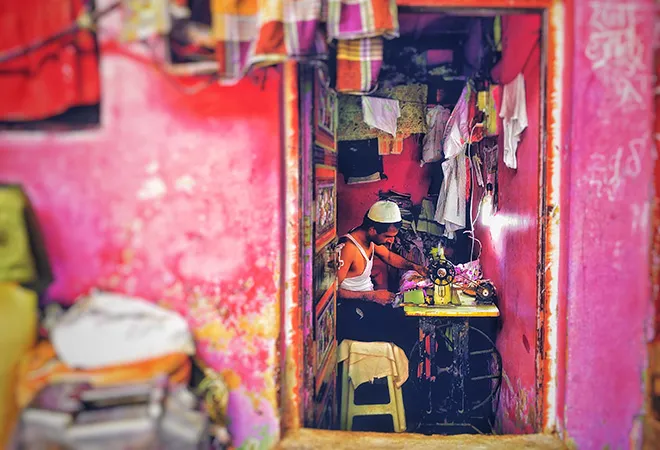
One of the unintended outcomes of the COVID-19 pandemic has been a groundswell of support from local residents to
expedite the redevelopment of Dharavi, one of the largest slum clusters in Asia. Resident committees from Dharavi have asked the Uddhav Thackeray government to fast-track the INR 280 billion project that has been languishing for the past 15 years, and has got redrawn on the desks of five chief ministers, primarily because of lack of consensus between the inhabitants and the government.
The fresh demand for the revival of the project, this time from the residents themselves, and also the renewed global focus on the area, has also promoted Maharashtra’s housing minister Jitendra Awhad to put the focus of the government back on the oft-derailed project, which promises to pave the way for its quick implementation.
Resident committees from Dharavi have asked the Uddhav Thackeray government to fast-track the INR 280 billion project that has been languishing for the past 15 years, and has got redrawn on the desks of five chief ministers, primarily because of lack of consensus between the inhabitants and the government.
Dharavi, spread over 239-hectares and housing close to one million people, had become the
epicentre of the COVID-19 pandemic in May 2020. Recently after a three-month long intervention, the World Health Organisation (WHO) Director General Tedros Adhanom Ghebreyesus had
praised the Mumbai civic body for successfully containing the outbreak in what was being feared as the most sensitive COVID-19 hotspot in India. He praised the ‘community engagement’ part and the city government’s formula of ‘testing, tracing, isolating and treating all those that are sick’ in Dharavi, which has helped in arresting the pace at which the virus was spreading.
The redevelopment project will look at the revamp of a 239 hectare area, in the heart of Mumbai, housing close to one million people. At present, this cluster houses
20,000 small-scale work units, while the rest are shanties with community toilets —
one toilet complex shared by about 1,400 people. The work units are of leather export, textile and zari work, glass, pottery and recycling, contributing to Dharavi’s one billion dollar economy.
The redevelopment project will look at the revamp of a 239 hectare area, in the heart of Mumbai, housing close to one million people.
The
redevelopment plan of Dharavi first got introduced in February 2004, and then it kept hitting headlines before every election, featuring on political party manifestos, but without making any breakthrough. After showing signs of some progress under different chief ministers, the plan got stuck each time mainly owing to the failure of a third of the total residents to meet the eligibility criteria and general political apathy. The last development on the project was seen in early 2019 when the Devendra Fadnavis government approved a new redevelopment plan and even allotted the tender. But just as the project seemed to be ready for a takeoff, it got once again grounded due to a technical issue — 45 acres of railway land abutting the Dharavi redevelopment area became a part of the project after the tender was issued and the formal work order got stalled. The slum dwellers were also unhappy that the government was shortchanging them by giving them free tenements of only 350 square feet as opposed to their demand for 500 square feet homes. The new government formed in November 2019 is planning to take it ahead from this point. In its
recent letter to Thackeray, the Dharavi Redevelopment Committee, the residents organisation, has requested him to not re-tender and waste any more time, and go ahead with what has been decided by the earlier government.
While the Uddhav Thackeray government is sure to consider the technicalities of the tender, it is a great opportunity for them to pitch this project as a new paradigm in slum redevelopment globally.
But just as the project seemed to be ready for a takeoff, it got once again grounded due to a technical issue — 45 acres of railway land abutting the Dharavi redevelopment area became a part of the project after the tender was issued and the formal work order got stalled.
The complexity of Mumbai’s geography along with its bursting population has created lopsided informalities that the city needs to reconsider. As per census 2011, there are
53 million people living in the slums, and these areas account for hardly 8 percent of Mumbai’s land space. Successful redevelopment of Dharavi could thus set a benchmark not only for the redevelopment of other informal settlements that dot the landscape of India’s commercial capital, but all other urban centres that are grappling with the problem of hyper-dense slums within India and globally.
Slum rehabilitation in Mumbai, as with other cities across India has long suffered from a policy paralysis and there is no consensus to improve this. Under the policy, the
Slum Rehabilitation Authority (SRA) in Mumbai monitors the redevelopment of shanties. A patch of land consisting of a slum cluster is given to a private developer. The rules require him to build free houses for the slum dwellers on 30 percent of this land, and the remaining portion is used for constructing luxury homes that are sold on the open market at a premium. Under this model, the proceeds from sale of luxury homes on open market subsidises the ‘free component’ allotted to the slum dwellers. In reality, the standard of ‘free tenements’ constructed remains poor and they lack necessary amenities that are generally to be taken for granted in any formal settlement. The lack of ventilation and non-compliance with space norms results in a high density ‘vertical slums.’ If one considers that all eight percent of land occupied by informal housing goes for redevelopment following the existing norms, we will be cutting down the existing land by 70 percent. This will mean that only three percent of Mumbai land will be used for actual resettlement.
Slum rehabilitation in Mumbai, as with other cities across India has long suffered from a policy paralysis and there is no consensus to improve this.
Lessons drawn from the COVID-19 pandemic draw out the importance of better social housing with not only better homes, but better living conditions and environment in terms of the open spaces, sanitation and water, common corridors between the buildings, education, health and social amenities. This poses a great opportunity for community cluster planning where slum redevelopment is not looked from an individual tenement perspective but as a space to live, work and recreate the economy. It has to break away from being market- and builder-driven to public- and government-driven. These changes will need to be first reflected in development control rules (DCR’s) of cities, where redevelopment projects will have to follow minimum space and ventilation norms, else we will end up creating monstrous vertical slums, as has been the case with several SRA projects in Mumbai. While affordable housing is high on the agenda of every government, it must be a consideration in clusters like Dharavi where several levels of mixed housing can be created.
Providing free housing has become a populist policy decision in redevelopment projects in Mumbai that no party in power would ever want to revoke. However, offering additional space to the slum dwellers for a cost is something that needs to be seriously considered. Such additional space could help families run small-scale work units or supplement their income by giving it out on rent, or even be used later when families grow.
Providing free housing has become a populist policy decision in redevelopment projects in Mumbai that no party in power would ever want to revoke.
There has to be a consideration for affordable housing, which could be extended to the
6 million strong migrant population that works in Mumbai. The cost of these homes should be worked out according the affordability of those who will occupy them and not be dictated by the market. There is a huge scope for development of public low-rental housing in such clusters.
The move for Dharavi’s redevelopment is necessary. This project if rolled with a ‘people-centric’ approach and ‘community-driven’ intention, will set a new model for slum redevelopment globally.
The views expressed above belong to the author(s). ORF research and analyses now available on Telegram! Click here to access our curated content — blogs, longforms and interviews.



 One of the unintended outcomes of the COVID-19 pandemic has been a groundswell of support from local residents to
One of the unintended outcomes of the COVID-19 pandemic has been a groundswell of support from local residents to  PREV
PREV


